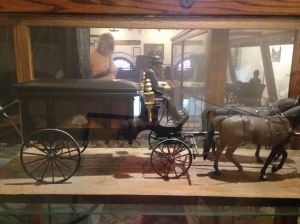A Primer on Horse Drawn Carriages
The prime mode of transportation in 1900 was still horsepower. Cars had been invented, but simply wouldn’t become commonplace for another decade. What people may not understand were that there were many different conveyances. Here are some pictures to help you picture the different rigs in the stories you read.
I’ll do this over a few posts. These photos are scale models taken at the Adams museum in Deadwood, SD. I highly recommend you visit if you are ever in the area.
 This would be the common wagon, sometimes called a buckboard and though this rig does have a buckboard (the front wood slat that acts as both footrest and protection for the driver in case the horse bucks) as far as I can tell an actual buckboard is less for carrying goods and more for personal conveyance.
This would be the common wagon, sometimes called a buckboard and though this rig does have a buckboard (the front wood slat that acts as both footrest and protection for the driver in case the horse bucks) as far as I can tell an actual buckboard is less for carrying goods and more for personal conveyance.
This would be a variation on a buggy. It was usually pulled by one horse. This one isn’t covered, but many buggies were covered. This one looks like it was meant to be for a doctor with the small hatch on the back.
These don’t have the shape of the Conestoga and are probably just considered covered wagons. People used these to move west, sometimes with teams as large as 12 oxen. It takes a lot of power to move a family west.
Where you have people, you have death and the hearse is a necessary vehicle. We don’t often think of a hearse as anything but a long black car, but they’ve been used for much longer.
I’ll post more on various horse drawn conveyances soon.




